Posts in Category: Uncategorized
The Art Festival
 On Saturday, Barry and I took the kids to an art festival that we have enjoyed many times over the last several years. The weather was beautiful and I knew we had to get out of the house because Gray was trying to fling open every door and would throw himself to the ground in an angry crying heap each time he discovered the doors were all locked. We had not been to this festival since Gray outgrew his stroller and I was curious to see what new artists might have popped up in our absence. Zoe and Lena were fired up because the kids’ area promised to have some exciting projects. Barry was nervous, but agreed to go under the premise that I promised to buy an extra-large bag of kettle corn.
On Saturday, Barry and I took the kids to an art festival that we have enjoyed many times over the last several years. The weather was beautiful and I knew we had to get out of the house because Gray was trying to fling open every door and would throw himself to the ground in an angry crying heap each time he discovered the doors were all locked. We had not been to this festival since Gray outgrew his stroller and I was curious to see what new artists might have popped up in our absence. Zoe and Lena were fired up because the kids’ area promised to have some exciting projects. Barry was nervous, but agreed to go under the premise that I promised to buy an extra-large bag of kettle corn.
As we descended on the festival, we split up in the traditional manner: Barry took the girls and I commandeered Gray and Hope. At first, I tried to join Barry in the kids’ area to see if Gray might be interested in any of the activities. When he started grabbing at other people’s food, I knew we needed to move along. We walked over to the kettle corn cart and purchased a very large bag. Gray was excited and kept saying “pa pa pa” as we strolled back to find Barry and the girls. We shared our kettle corn as the girls finished up painting their canvases and went to check on their spots on the pottery wait list. I felt very relaxed with Gray and Hope close by my side when, suddenly, I felt a strong pull on Hope’s tether. I was bewildered and looked around to see what kind of large fish I had hooked on my line. In the crowd of kids, I could not see Gray and I could not imagine where he had gone. Just like a fisherman, I walked my hands down the tether line until I found him at the end. He was standing at the pottery table eating clay. I gave Hope a good pat and said a silent “thank you” prayer. Without her, I would have felt panicked in my inability to find Gray. With her, his retrieval was just a simple fishing expedition. I peeled the clay out of his mouth and we left the kids’ area to walk around in less interactive areas.
We walked up and down the aisles looking at the booths of the various artists. Of course, there was no stopping or shopping, but I reminded myself that that my two typical kids would not allow me to stop or shop either. The difference is that while my typical kids would just whine and complain, Gray would protest by dropping to the ground and wailing. Either way, I set my expectations for a quick tour of the festival and I considered all of the money I saved by being denied a thorough inspection of all the booths.
Gray seemed to be enjoying himself as we maneuvered through the crowd. There were lots of sights, sounds and smells. Then, he started enjoying himself a little too much. As he started jumping and increased his walking pace, I felt nervous that mania was about to rear its ugly head. Within moments of me having that thought, a person who passed us let out a yelp. I immediately looked at Gray and considered the look of glee on his face. His left hand (the one that does not hold Hope’s handle) was up and ready to pinch any poor soul who might wander too close. I struggled to correct him, but I won’t lie: many people were pinched that day. I made a quick turn and started guiding Hope and Gray back to the kids area so that Barry and I could make a plan. On the way, there was a bench where an older man was sitting peacefully. Gray sat down next to him and let out a sigh to show that he was getting tired. He then draped his arm over the man’s lap and leaned into him. “Sorry about that. We are not really good with boundaries,” I explained. The man couldn’t have been nicer and told me that he was happy to have such friendly company. Gray looked very calm, so I let my guard down and sat on his other side. The man asked me about Hope and commented on how pretty she was. Gray stroked the man’s leg and I started apologizing again. The man just looked down at Gray and said, “He’s fine! He’s not doing any harm.” In that moment, Gray and I both made the same realization: that man was wearing glasses. My stomach dropped. With lightening speed, Gray had ripped the glasses off of his bench-mate’s face letting out a squeal of laughter. I quickly unwound his fingers from the glasses and gave them back to the man with deep apologies. We got up to go and that sweet man just laughed and told us to enjoy our day.
It’s unfair really: One of the reasons that ASDA uses labradors, golden retrievers and doodle mixes is because these are friendly-looking breeds. The idea is to attract other people and kids to interact with a child they might otherwise have avoided. This is supposed to encourage socialization and help children with autism get comfortable interacting with others. Instead, Gray uses it as a web to trap his next victim. I am grateful for the kind people who pretend to understand when my clearly disabled and adorable 7-year-old causes harm, but I know we must get this problem fixed soon. I fear that, by the time Gray is a teenager, he will be far less adorable and downright formidable.
I think I will pour another glass of wine while I ponder that dilemma.
My only journey into alternative treatments – Part 2
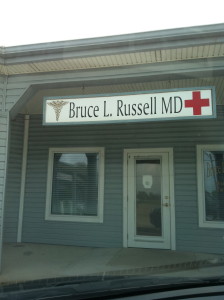 Just to recap: After years of rejecting all forms of “alternative” therapy, last summer I found myself pursuing one doctor’s theory that seemed to make sense to me.
Just to recap: After years of rejecting all forms of “alternative” therapy, last summer I found myself pursuing one doctor’s theory that seemed to make sense to me.
His blood had been drawn, I had filled out a book of documents and I had a 5-inch thick folder containing all of his previous medical and therapy records. As our plane landed in Corpus Christi, I let my mind go to the places I had carefully kept at bay: What if this doctor had the answer to Gray’s disorder? What if I had a shot at having a relatively-normal son? What if this treatment actually worked, but it was just so new that it had not had time to go through all of the research and testing that I used as a qualification for all of the other things I did for Gray? I was excited and hopeful and very very vulnerable.
I had arranged for our flight to arrive 3 hours before our appointment time. I didn’t want to risk a flight delay or any other travel problems that could cause us to miss our long-awaited appointment. When our plane arrived as scheduled, I knew I would have to think of some ways to spend our extra time in this unfamiliar town. We got our rental car and made the 50 minute drive to Port Aransas where the doctor had his office. One hour down, two to go. The drive was bleak and the scenery was unimpressive. Port Aransas is a fishing town next to oil refineries. I suspect that there is not one building there over three stories tall. After we burned about 40 minutes in a Dairy Queen (we finally had to leave when Gray became fixated on running into the kitchen), I found our way over to a playground. It was sticky-humid and hot. I pushed Gray on the dilapidated swings and called a girlfriend for emotional support. I was stressed. The combination of eagerness, anxiety and the burden of entertaining Gray in this strange place felt lonely and wrong. I remember telling her that I just could not imagine that “THE ANSWER” was in a place like this. It couldn’t reside among these shirtless retirees with fishing poles. Suddenly, Gray leapt off of his swing and started sprinting for the parking lot next to the playground. I dropped the phone in the grass and ran after him screaming for him to stop. And so he did; right in front of a car that was driving through the parking lot. He just sat down on the ground with no awareness that a car was about to plow him down. I waved and screamed and the driver of the car slammed on his brakes about 3 feet in front of Gray. I snatched Gray up off the ground and dragged him back to my car. When he was securely buckled in the back seat, I went back for my phone where my girlfriend was waiting to hear that disaster had been averted.
With an hour left to burn, I drove around the island and parked my car by a public beach. We were far from any traffic, so I unbuckled Gray and we went for a little walk on the sand. Within 5 minutes, Gray wiggled out of my grip and ran headlong into the surf. I caught him before he actually entered the water, but he threw himself on the ground in the wet sand and let the thin waves wash over his fully-clothed body. When I had scooped him up and we were securely back in our car, I lamented our state of affairs. I had brought a change of clothes for him, but not for me. We showed up at the doctor’s office 30 minutes early. We were both sticky, sandy and disgusting. I did my best to breathe deeply and remind myself that I just needed to get through this day and this appointment. There was never a mother more desperate to find help for her child than I was in that moment.
The doctor and his staff could not have been more kind and helpful. I tried to reserve judgement on the very small-town feel that this tiny clinic in a strip mall radiated. The doctor went over all of Gray’s lab work and completed his examination. At the end of it all, he told me that, while Gray’s symptoms were the same as his other neuro-immune deficient patients, Gray’s lab work did not show the same (or any) abnormalities. The theory behind this treatment approach is that our children have been infected with a virus similar to herpes. This virus had attacked their brains and caused a neuro-immune dysfunction that presents as the disorder we call autism. Gray did not show any viral load in his blood work. He did not show any yeast overgrowth or signs of infection of any kind. This doctor and his clinic were not Gray’s answer. I felt my heart fall. And when the doctor recommended that we try the protocol anyway (the special diet, the anti-yeast medication, the anti-inflammatory medication, and the other medications on the plan), my heart fell even more. I knew that there was nothing this doctor could do or prescribe that would make any difference in Gray. I knew that proceeding down this path would only make me like the other parents that I had judged and pitied.
Over the next few hours as Gray and I made our way back home, I considered my feelings. I had allowed myself to have hope and I had spent time and money and unbelievable energy to pursue it. As I mentally put an “X” in the box next to this possible treatment, I no longer felt judgement or pity for the other families who felt the need to go on a similar search. For us, this was a dead end. For me, it was a stretch beyond my comfort zone of certainty and evidence. I had joined the ranks of parents who are willing to try crazy things for their kids.
So, although this was not our solution, I am glad I gave it a try.
My only journey into alternative treatments – Part 1
When I worked in an in-patient hospital setting on the brain injury team, I saw a lot of families struggling to make sense of the devastating thing that had happened to their loved one and, by extension, their family. I watched people move through the stages of grief and I watched people get stuck on the idea of finding a way to make this injury go away. I knew families that traveled to foreign countries for treatments that were not available in the U.S. and families who sought advice from alternative medicine advisors here in our country. There were stories of stem cell transplants and hyperbaric chambers and herbs and oils. Of course, all of these treatments and travel expenses cost large sums of money that were not covered by insurance. It was hard to watch these families act in desperation and, at times, turn against the established medical care they were receiving. It was even harder when the patients returned with little or no improvement after their treatments.
When Gray first began receiving services for autism, he was enrolled in a pre-verbal program at the Callier Center for Communication Disorders. This was a preschool-type program for very young children who had not developed language skills.The program lasted for 2 1/2 hours each morning. Many of the families traveled for up to 1 hour to get to the center, and there was an observation room above the classroom, so lots of moms would just go up there and wait/observe while their children were in therapy. Because of the age of the kids enrolled, many of them had not yet received a formal diagnosis or were going through the process and had just been diagnosed with autism or some other developmental delay. This mixture of anxiety-ridden moms with extra time on their hands was a dangerous combination. I am sure that there are women who were in that room who would tell me that it was a fabulous environment for collaboration and support, but to my eyes, it was the same as I had seen before: desperate parents being exploited by “alternative” medical professionals.
These moms would sit in the observation room with their binders of contacts and lab work and diets and supplements and compare notes. The problems I had were these:
None of the contacts were medical doctors with hospital privileges. They were doctors, but they were operating outside of the established medical environment. None of them were in network with any insurance companies. There was only one lab in the country that would process their bloodwork or urine/stool samples. They sold supplements that ran up to $1000 per month that could only be purchased in their offices. And, they did all of this under the premise that the traditional medical field could not be trusted. They claimed that there was a conspiracy among doctors and the pharmaceutical companies that kept the truth about curing autism suppressed.
I took issue with all of this. First, I do not believe that doctors are conspiring with anyone to keep autism from being cured. I have known too many doctors in my life to believe such a ridiculous claim. Doctors go into the medical field to help people. Yes, there are good doctors and bad doctors and ethical ones and unethical ones; but overall, the vast majority are just trying to help. Conversely, these alternative doctors are trying out treatments on patients that have no evidence-based research to support the things they are trying on these kids. That seemed dangerous to me. Second, I am immediately skeptical about any lab work that can only be processed by one lab in the world. Lab work should be an objective measure and any lab should be able to look at anything that is legitimately out-of-whack. Third, the expensive supplements just looked like a money-making scheme to me. Why must they only be bought from the doctor who prescribed them? If a doctor truly believed that a patient had a deficiency of some vitamin or essential nutrient, they could write it down and let the family buy it at a store that sold vitamins, right? So, I concluded, these doctors appear to be exactly what they accuse traditional doctors of: charlatans who take advantage of parents who would do anything for their disabled children.
I spent the next few years keeping my head down among other autism parents. I continued to load Gray up with therapy and I started him on medication that our neurologist prescribed. I did not put him on any special diets or give him any supplements. I took him to a regular allergist for allergy testing and management and I consulted with a licensed dietician (note the word “licensed”) to ensure that his diet had all the nutrients he needed. I did not share my opinions with the other moms unless they asked me. Much like anything else in parenting, I understand that a parent must do whatever they can to feel like they have done everything they can for their child. There is no peace until you feel like you have explored all viable options. I get that, but, in many instances, I would poll therapists in a variety of professions who worked with children like mine and they all reported few to no improvements in the kids that they saw who were participating in alternative treatments.
Then, about a year ago, I read a book that was suggested to me entitled, The Myth of Autism, by Dr. Michael Goldberg. I won’t go into all of the details, but, in a nutshell, Dr. Goldberg proposes the theory that our children are not actually suffering with classic autism, but a neuro-immune dysfunction that is caused by a viral infection. This was interesting to me. He described kids with symptoms that were similar to Gray’s: lots of allergies, digestive problems, eczema, increased susceptibility to upper respiratory infections and bizarre instances of body parts turning red (Gray’s right ear often turned red for no reason). As I looked into this doctor’s practice, I felt relieved to learn that he was in-network with several insurance companies, did not sell any supplements or prescribe any alternative treatments and he only ordered lab work from national lab companies that could be processed anywhere. That made me feel like he had a level of legitimacy. On the flip side, there are only 3 clinics in the country that practice his protocol: his office in L.A., a clinic in New York, and a doctor’s office in Corpus Christi. This part was a little strange to me, but the other factors outweighed my bewilderment and I decided to make an appointment with the office in Corpus Christi. My neurologist was extremely wary of my decision and warned that his methods had no research to back them up. I told her I understood, but I needed to pursue this avenue if only to learn more about it.
Two months later, Gray and I were on a plane for a day trip down to the Gulf Coast.
In the interest of keeping these posts a manageable length, I will continue my story in my next post.
Girls Day Out
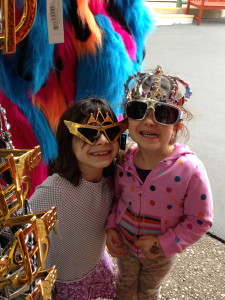
 Last Friday was a rare day. Zoe and Lena were out of school and Gray was not. In my anticipation of this monumental event, I spent hours considering the best way to spend this precious time when the girls would have me all to themselves. I savored the thought like I was planning some elaborate vacation and imagined the three of us at a beach or day spa. Of course, with a 9-year-old and a 3-year-old, my options were limited to activities that they would both enjoy. I decided that the most special activity would be a trip to Six Flags. We all have season passes and the weather was perfect and I knew they would both be thrilled with the plan.
Last Friday was a rare day. Zoe and Lena were out of school and Gray was not. In my anticipation of this monumental event, I spent hours considering the best way to spend this precious time when the girls would have me all to themselves. I savored the thought like I was planning some elaborate vacation and imagined the three of us at a beach or day spa. Of course, with a 9-year-old and a 3-year-old, my options were limited to activities that they would both enjoy. I decided that the most special activity would be a trip to Six Flags. We all have season passes and the weather was perfect and I knew they would both be thrilled with the plan.
After we dropped Gray and Hope off at school, we started our day with a girls breakfast. Over croissants and strawberries, we talked about our plans for the day, excitement for summer and Lena’s plans to get her hair cut like Zoe. Instead of zoning out to movies in the back seat, the girls requested dance music on the radio so we could get revved up for our outing. We were pleased to find a practically empty amusement park with no lines to slow us down as we ran from one ride to the next. The weather was overcast and 75 degrees, so no one complained about being too hot or too cold. After doing such a nice job taking turns on who got to pick the next ride, I granted their wish to commemorate our special day with airbrushed t-shirts. I must admit, as a child of the 80’s, I have always wanted an airbrushed shirt. Unfortunately, they don’t have the kinds with beaded fringe at the sleeves anymore, but I was very pleased with all of our choices.
As we rode the train and the girls reclined on my lap, I made note of how RELAXED I felt. The idea amused me because I know most parents have a hard time feeling relaxed at an amusement park with their kids. I suspect that most parents see it as a labor of love to endure a day like this. Instead, I soaked in their happy little faces and I noted that I was independently enjoying the day. We were just 3 carefree girls who were not at the mercy of Gray’s unpredictable mood swings or limited patience. Even though Hope has allowed us more freedom as a family, taking her and Gray out is still a big project…in a way, I am tethered to the service dog along with Gray. By contrast, a day with these 2 typical kids was a breeze. With my best deep-yoga breath, I soaked in the moment.
We returned home just as Gray was coming in from school. Zoe exclaimed,”Hi Buddy!” Lena ran to give him a hug before laying on top of Hope. Everyone sat down at the table to have a snack and watch some cartoons. After a day on our own, we all felt ready and recharged to reconnect with Gray on his terms.
Dear Tooth Fairy:
 Zoe lost a tooth yesterday. She has been fired up all week to see how much the tooth fairy would bring. This is her first molar to go and she is certain that larger teeth should win larger cash awards. I guess she had a moment of generosity and decided that her tooth might be used for a greater good. As we were putting her to bed, she showed us the note that she wrote to go under her pillow along with the tooth. Here is what it says (verbatim, I did not change or correct any part of this):
Zoe lost a tooth yesterday. She has been fired up all week to see how much the tooth fairy would bring. This is her first molar to go and she is certain that larger teeth should win larger cash awards. I guess she had a moment of generosity and decided that her tooth might be used for a greater good. As we were putting her to bed, she showed us the note that she wrote to go under her pillow along with the tooth. Here is what it says (verbatim, I did not change or correct any part of this):
From: Zoe
Dear: Tooth Fairy
I’ve heard that you could grant a wish instead of money but you can only do it once and then you can only give me money but if you can’t it’s ok. But, if you can than my wish is that my brother Gray who has autism gets a cure for it. I would like the cure for him tomorrow morning or at latest next Monday. But again, if you can’t grant my wish it is ok. but my friend did say she wished for a hamster and her wish came true but maybe she is lieing. I don’t know because she has a different tooth fairy.
P.S. If you have your magic fairy dust please leave some on the bed or ground.
Then, she drew two boxes and asked the tooth fairy to leave her name and a drawing of what she looks like.
Gray may not wake up cured this morning, but he will wake up in a home with a family who loves him dearly…even if it means giving up our tooth fairy money.
Joshua Prager on TED
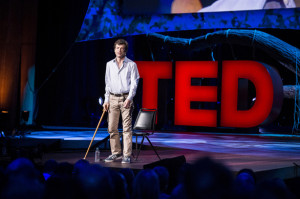 I have become a TED talk junkie. In the evenings, when I take Hope for her walk, I have started taking headphones and listening to TED talks. They are an excellent way to expand your mind in various subjects: medicine, psychology, culture, food and countless other topics. I try to pick a variety, but, I must admit, I am drawn to the stories of people who overcome adversity. I guess I see myself as one of those people and I am looking to connect. I made one such connection when I listened to the talk given by Joshua Prager earlier this month. I was drawn to the topic of “In search of the man who broke my neck” because I have spent so much of my life working with people who have suffered spinal cord injuries. I feel connected to them because I know that the general public is very uncomfortable around people in wheelchairs and I am not. I also feel a kinship because I know what it is like to struggle with everyday activities that typical people take for granted.
I have become a TED talk junkie. In the evenings, when I take Hope for her walk, I have started taking headphones and listening to TED talks. They are an excellent way to expand your mind in various subjects: medicine, psychology, culture, food and countless other topics. I try to pick a variety, but, I must admit, I am drawn to the stories of people who overcome adversity. I guess I see myself as one of those people and I am looking to connect. I made one such connection when I listened to the talk given by Joshua Prager earlier this month. I was drawn to the topic of “In search of the man who broke my neck” because I have spent so much of my life working with people who have suffered spinal cord injuries. I feel connected to them because I know that the general public is very uncomfortable around people in wheelchairs and I am not. I also feel a kinship because I know what it is like to struggle with everyday activities that typical people take for granted.
As I listened to Joshua’s TED talk, his message reverberated through me in a way that I can only describe as “like-mindedness.”
Like Joshua, I sometimes divide my life. I divide it as BA (before autism) and AA (after autism). It doesn’t happen as frequently as it used to, but there are times when I will look at pictures or tell stories from when we lived in our other house and I will think about what a different person I was then. I think about how different my expectations of life were and the silly things I thought were stressful. Yes, I was still a person who advocated for others with disabilities, but they were not my own or my family’s.
In graduate school, learning about all of the maladies that can affect humankind was a little scary. Each time we learned of a new disease or condition, someone in our class would feel sure that they had it. Each time we learned about a childhood disorder, we feared that we would have children with those problems. I remember telling my roommate that it almost seemed like we were being prepared: who better to deal with these challenges than someone who had been trained to understand them so well? What I have learned is that, when your worst fear comes true, you can still live through it and even thrive…if you have the right attitude.
I would like to give a few quotes from Joshua’s talk that spoke to me and made me consider my life:
-I then began to wonder, as I had many times before, how my life would have been different if this man had not injured me…had my genes been fed a different helping of experience. Who was I? Was I who I had been before the crash, before this road divided my life like the spine of an open book? Was I what had been done to me? Were all of us the results of things done to us, done for us? …the infidelity of a parent or spouse, money inherited…Were we, instead, our bodies? Their inborn endowments and deficits? It seemed that we could be nothing more than genes and experience, but how to tease out the one from the other? As Yates put that same universal question, “Oh body sways to music! Oh brightening glance! How can we know the dancer from the dance?”
-People are wrong to marvel at those like me who smile as we limp. People don’t know that they have lived through worse. That problems of the heart hit with a force greater than a runaway truck. That problems of the mind are greater still, more injurious than a hundred broken necks. I wished to tell him that what makes most of us who we are most of all, is not our minds and not our bodies and not what happens to us, but how we respond to what happens to us. This, wrote the psychiatrist, Victor Frankel, is the last of the human freedoms: to choose one’s attitude in any given set of circumstances. I wished to tell him that not only paralyzers and paralyzees must evolve– reconcile to reality–but we all must: the aging and the anxious and the divorced and the balding and the bankrupt and everyone. I wished to tell him, that one does not have to say that a bad thing is good. That a crash is from G-d and so a crash is good; a broken neck is good. One can say that a bad thing sucks, but that this natural world still has many glories. I wished to tell him that, in the end, our mandate is clear: We have to rise above bad fortune. We have to be in the good and enjoy the good: study and work and adventure and friendship (oh, friendship!) and community and love. But most of all, I wish to tell him what Herman Melville wrote: “That truly to enjoy bodily warmth, some small part of you must be cold. For there is no quality in this world that is not what it is merely by contrast. Yes. Contrast. If you are mindful of what you do not have, you may be truly mindful of what you do have. And if the gods are kind, you may truly enjoy what you have. That is the one singular gift you may receive if you suffer in any existential way. You know death, and so may wake each morning pulsing with ready life. Some part of you is cold and so some other part of you may truly enjoy what it is to be warm.”
I agree with Joshua’s interpretation of our mandate. Almost everyone goes through something difficult in their lives. Almost everyone finds themselves in a situation at some point that brings them to their knees. The secret to happiness is not in the luck of the draw. I believe that happiness is a choice. Those of us who have it a little rougher just have the gift of contrast.
And then there are the setbacks…
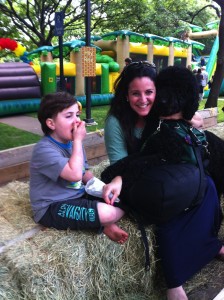 As my confidence grows and my search for a weekend therapist lingers on, I have embraced each weekend as a chance for new adventures. Barry was sick last weekend, so I heroically offered to let him stay in bed and rest on Saturday while I managed the kids. After hearing Zoe complain that she was bored for the 15th time, we called a friend of hers and invited her to the mall for lunch and walking around. Yes, I took 3 typical children, 1 child with autism and a dog to the mall BY MYSELF. That is how cocky I am getting. And, you know what? It went beautifully. Sure, the girls bickered and Gray asked (on his iPad) to be taken to the bathroom multiple times, but when we left, I felt no more frazzled than any other parent who takes a group of kids to the mall. The day was a huge success: the kids had fun, we burned a few hours, Barry heralded me as the best wife ever for letting him sleep off his cold and I felt good about the world.
As my confidence grows and my search for a weekend therapist lingers on, I have embraced each weekend as a chance for new adventures. Barry was sick last weekend, so I heroically offered to let him stay in bed and rest on Saturday while I managed the kids. After hearing Zoe complain that she was bored for the 15th time, we called a friend of hers and invited her to the mall for lunch and walking around. Yes, I took 3 typical children, 1 child with autism and a dog to the mall BY MYSELF. That is how cocky I am getting. And, you know what? It went beautifully. Sure, the girls bickered and Gray asked (on his iPad) to be taken to the bathroom multiple times, but when we left, I felt no more frazzled than any other parent who takes a group of kids to the mall. The day was a huge success: the kids had fun, we burned a few hours, Barry heralded me as the best wife ever for letting him sleep off his cold and I felt good about the world.
So, as you would expect, I was looking forward to the carnival at Lena’s preschool on Sunday. We had already done a carnival at the elementary school, the weather was beautiful and Barry felt well enough to join us. What could go wrong?
Within moments of arriving at the carnival, the girls ran to the petting zoo and Gray ran for a bounce house. Barry and I split up: he had Zoe and Lena while I took Gray and Hope. As we traveled from activity to activity, I made little mental notes of questions I never thought to ask during my training with Kati:
Is it wise to put a dog in a bounce house? (I didn’t, of course, but the idea was amusing.)
What to do when Gray enters the bounce house (alone) and jumps right out of his tether belt so that I have nothing to hook him to when he comes back out? (A: Ask a preschooler who has just barely mastered the English language to go in the bounce house and “get that black strap over there in the corner…not that corner, over there…no, not there…YES, YES! That strap there! No, don’t put it on, bring it to me, please.”)
If Hope goes in the petting zoo, does she become one of the petting attractions?
What is the best way to load a boy and dog who are tethered together on to a tractor for a hay ride?
Yes, the day was great fun and everyone was enjoying the carnival, until…a kid got in the bounce house wearing glasses. Gray is obsessed with ripping glasses off of people’s faces. It’s a charming habit. As soon as I saw that kid get in the bounce house, my stomach dropped. Gray lunged for the glasses and pulled them off that poor boy’s face before he even realized he was under attack. The kid screamed and tried to grab his glasses back. I tried to reach my arm through the webbing of the bounce house “window” to get hold of Gray’s arm. I yelled for the kid to wait and let me get the glasses back for him. I knew that the glasses would not hold any interest for Gray now that they were off of their owner’s face. I knew that, if the kid would just relax a second, Gray would drop them or give them to me. Of course, this 4-year-old now missing his glasses was only slightly more coherent than Gray. He was clearly panicked to get his glasses back and started a game of tug-of-war that miraculously ended with him rolling over backwards with his glasses in his hand. I only took a moment to celebrate the glasses remaining intact. Now, Gray had snapped into full-blown mania. He started laughing hysterically and dropping kids to their knees with pinches or hair-pulling.
Hope and I leapt over many small bodies to run back to the front entrance of the bounce house. I thrust Hope’s leash into the hand of the bewildered attendant at the entrance and told her to hold my dog while I saved those kids. It was like a scene out of a bad comedy: Gray was moving lightening-fast among his victims and small children rolled around crying for their moms inside the mesh barriers. I dove head first into the entrance and caught Gray by an ankle. As I dragged him out, other parents looked at me with confused and horrified eyes. I don’t know how many times I apologized. I really think I just kept repeating it like a mantra, “I’m so sorry. He is autistic. I’m so sorry. He is autistic.”
As I pulled him free of the bounce house and got him to his feet, I turned to gather Hope and re-attach her tether to Gray’s belt. That’s when Gray sank his hand into a lovely mop of curly hair. The girl with the lovely hair shrieked and I whipped around to start untangling Gray’s fingers. I began my mantra again, but the mother was clearly unnerved by how long it was taking me to get Gray to let go. I tried to explain that it would take me a minute to get his hand unclenched, but she did not seem to understand what I was saying. I finally freed the girl and left her to cry in her mother’s arms as Gray and I escaped the scene.
I saw Barry across the way, and I just pointed to the car and yelled, “we will meet you there!” He nodded and started to gather the girls. When we finally made it back to the car, I could not wait to get Gray locked down in his car seat. It wasn’t until after I got him untethered and into the car that I realized: In all the excitement, he had soiled his pants and it had run down his legs. I now had it all over me and the car seat. I buckled him in and put Hope in the far back of the 3rd row so that she would not become another casualty. I cursed my glove box that only held dried-out wet wipes. I even withheld my sarcastic remarks when Barry arrived with the girls and said, “Wow, it smells terrible in this car!”
So, believe it or not, I think that the event was more or less a success. I mean, we had 90 minutes of family fun before disaster struck. If only people would stop bringing their glasses-wearing kids out to places like this, it would prevent problems like these from ever happening!
My second radio interview
Full disclosure: Before and after my last radio interview, I was a little bit of a wreck. I was nervous and fidgety as I waited for my call from the station and, afterwards, I did not feel good at all. I can only describe it as feeling like a deflated balloon. I guess there had been an adrenaline rush that left my body after I hung up the phone and I was left with a headache and a queasy stomach. Thankfully, I did not have the same experience with this interview. Because the last one went so well, I felt confident and relaxed as I sat in a car on my cell phone 1 mile from my house. I feel like this is important practice for me so that I can get ready for the “big interviews” that I hope will someday come. I know that I am recording something important here. I know that many people will benefit if they can hear my story. I pray that the opportunities will come so that I can get my message out:
There may not be a cure for autism yet, but there is a very real way to make life better while we wait!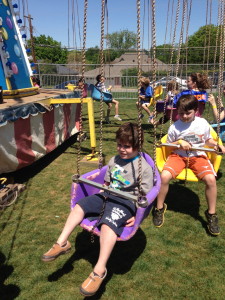
Click to listen to my radio interview: Kati is at the 11 minute mark and Rhoni is at the 17:45 mark
Insurance companies are evil
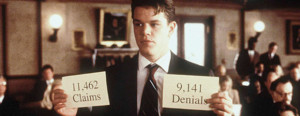 As I navigate the financial strains of therapy and doctor appointments for Gray, I am constantly bumping up against our insurance company. It reminds me of the courtroom scene from John Grisham’s movie “The Rainmaker.”
As I navigate the financial strains of therapy and doctor appointments for Gray, I am constantly bumping up against our insurance company. It reminds me of the courtroom scene from John Grisham’s movie “The Rainmaker.”
Q: Well, let’s talk about this mysterious section U. Why don’t we explain it to the jury. Take a look at it. Just read paragraph 3.
A: (reading) Claim handlers are directed to deny all claims within three days of receipt of claim. No exceptions.
Q: Now how do you explain this section U?
A: Well, sometimes we get some frivolous and fraudulent claims in our business. And sometimes we have to use this kind of language to focus in on the legitimate and more needy claims.
Q: Mr. Keely, do you honestly expect this court to believe that explanation?
A: Well, this chapter merely denotes in house processing guidelines.
Q: In-house processing guidelines? No, Mr. Keely, no it does not. Section U does a lot more than that.
A: I don’t think it does that, son.
Q: Mr. Keely, doesn’t it explain how claims should be rerouted and shuffled and rerouted, anything to avoid payment?
A: I admit nothing.
PL atty: Your honor, approach the witness?
Judge: You may.
Q: (Baylor hands Keely a huge book.) Now Mr. Keely, how many policies did great Benefit have in effect in the year 1995?
A: I don’t know but let’s see–
Q: Does the figure 98000 sound correct, give or take a few?
A: Maybe, that could be right, yeah.
Q: Thank you. Now of these policies, how many claims were filed?
A: Well, I don’t know that.
Q: Does the figure of 11,400 sound correct to you, give or take a few?
A: That’s about right, but I’d have to verify it, of course.
Q: I see, so the information I want is right there in that book? Can you tell the jury, of the eleven some-odd thousand claims that were filed, how many were denied?
A: Well, I don’t think I could. That would take more time.
Judge: You’ve had two months, Mr. Keely. Now answer the question.
A: Well, I, I don’t think (shuffling through book) Uh, 9141.
PL atty: 11462 filed, 9141 denied
That about sums up my experience with the insurance companies. They deny the claim first and then wait to see if anyone protests. In the early days, I would set aside about 90 minutes each week to argue with my insurance company. It was a maddening time-suck and often ended up with me in frustrated tears after requesting to speak with supervisors and enduring up to half-a-dozen transfers per call. I would marvel at the effort they would put me through. Occasionally, I would find a sympathetic representative and I would convince them to give me their direct contact information so that I could send my botched claims to someone who new what I was talking about. In the end, I would always get my claims paid, but I mourned for the other families in similar situations who likely did not have the same success I did. After all, I was a physical therapist who had spent my career fighting with insurance companies on behalf of my patients. I understood terms like “in-network,” “out-of-network,” “deductible,” “co-insurance,” and “pre-authorization.” I had armed myself with the Texas state law (House Bill 1919) that was originally written as a brain injury bill but had a section in it called the autism mandate that forced insurance companies to pay for behavioral therapy and nullified limits on speech, occupational and physical therapy for children who had an autism diagnosis. I had a copy of this mandate saved in my email so that I could send it or reference it whenever I needed to enlighten the person I was fighting with. What in the world were other families doing who did not have the information or the time to fight or the fortitude to reject the constant denials?
Over the years, the fight has gotten easier. Autism is twice as prevalent as it was 6 years ago (the frightening truth of that is best saved for another post). The insurance claims have, no doubt, followed this trend. Now, my insurance company has assigned me an “autism care advocate” in an effort to streamline these claims and keep track of their veracity. I can say now that I can go for many weeks without having to correct an insurance error and those that do require correcting only take up 15-20 minutes of my time. I have been feeling more comfortable with the process…until 2 weeks ago.
Gray’s behavioral therapist is a private practitioner who has worked with him for over 2 years. Because there were not a lot of “in-network” behavioral therapists when we started with her, the insurance company worked out an individual contract agreement with her. That means they negotiated her rates to their in-network standards and she had to file her reports with them so that she could get approval for the number of hours she could work with him each week. This was more work for her and less for me, but she took it on.
Last month, his weekly hours were up for re-approval. She filed all the paperwork and had a phone conference with the “peer reviewer.” (I love this term. It implies that the person on the other end of the line is a peer professional. Of course, they have similar credentials, but the fact remains that they work for the insurance company. After the review process was over, they decided that Gray did not qualify for the 20 hours per week that he had been receiving and dropped his allotment down to 15 hours per week. Never mind the evidence that showed he has been making progress (at a snail’s pace) and, therefore, really needs more therapy instead of less. We began the appeals process. This is in spite of the fact that my autism care coordinator told me that the decision was beyond appeal. In essence, she said “Here is an address you can write to. It won’t help, but at least you will feel like your complaints were heard.” Thanks. I needed a way to spend my extra time.
Then, two weeks later, Gray’s therapist told me that she had just received word that the insurance company was not renewing her individual contract and she would no longer be considered in-network. Of course, no one from the insurance company notified me of this. Of course, I was given no notice to consider my options. I called my autism care advocate to ask what was happening. He told me that the insurance company had more in-network providers now and they were trying to move their customers over to these bigger companies instead of using individual contracts. I told him that was all fine and good for new customers who had never worked with a therapist before, but kids with autism need consistency. It would be a horrible backslide to make Gray re-establish himself with a new set of therapists. I told him that I didn’t understand why our therapist’s contract had to be cancelled when it was causing no extra cost to the insurance company…she was billing the same as their in-network providers and she was submitting all paperwork according to their standards. I explained that this would not only be a disruption to Gray’s care, but it was a monumental task for me to search out a new provider whose schedule would match Gray’s availability. As I felt the tears welling up, I explained that parents like me have enough on our plate without having to spend our time arguing with insurance companies. He told me he understood because he has conversations like these everyday. I asked him, “You tell people that they have to flip everything over in their child’s life everyday? Your job title is ADVOCATE. Do you know what that word means?” When I asked if I could speak with his supervisor, he denied me access to her contact information and said he would send her a message to see if she might be willing to talk to me.
So, for the next 3 days, I called him and made him spend about 30 minutes on the phone with me as we rehashed the discussion above and I asked when I could expect to hear from his supervisor. Each time he denied me her contact information, but in our last conversation he gave me her name. I hung up the phone and called the main number for the insurance company. I explained to the person on the line that I had just been talking to <<supervisor’s name>> in the autism coordination department and our call was cut short. I asked if she could connect me to her directly and give me her extension to continue our conversation. It worked! Moments later, I was leaving a message on her voicemail that was lengthy, detailed and firm.
The next morning, I received a phone call from my autism care advocate. He informed me that he had been reviewing Gray’s case with his supervisor and they decided it would be in his best interest if they extended the contract another 6 months. They also encouraged my therapist to apply for in-network status so we could avoid this problem in the future. I thanked him for being so helpful and asked him to thank his supervisor as well.
Victory. For now. Now, how about that reduction in his weekly hours…
Halloween: Past and Future
Why am I writing about Halloween in April? Well, I have had some people ask me what life was like for Gray and our family before Hope. I am accustomed to rattling off a list of things that can and do happen when we have been out in the community, but it occurred to me that Halloween would be a perfect example of the progression we have made and where I hope to go.
Halloween is a BIG holiday in our neighborhood. The decorations on the houses around here rival Christmas and sometimes even surpass them. Trick-or-treating is one of the most anticipated events of the year and we always celebrate at a friend’s house whose street gets a lot of traffic. She orders pizza, we all take turns passing out candy and taking kids to the houses. Someone usually throws up from too many sweets: it’s a memorable event. Through the age of 4, we always just took Gray along in a stroller while Zoe ran up to the houses. He enjoyed being out, as long as we kept moving. He usually ended up falling asleep in the stroller after we parked it next to us on the porch and passed out candy.
Two years ago, I decided to give Gray a shot at trick-or-treating. The class at his pre-school program had been practicing it and I wanted to see how it would go. At first, Gray was happy and intrigued. We walked hand-in-hand along side Zoe who was thrilled to have her brother along. She patiently walked at his pace and escorted him up to the first house. She explained to the people at the door that he could not speak, but he loved candy. (Side note- Gray does not like candy. As sweet as Zoe’s intentions were, she absolutely seized on the opportunity to double her candy intake.) I helped Gray to open his bag and he marveled when strangers dropped things inside. We had a similar experience for 2 more houses. Then, Zoe grew impatient with our painfully slow progress. She started running ahead. Gray continued to be content just walking with me and looking at all the people for about 10 more minutes. Then, he started getting upset and struggling to have me release the grip I had on his hand. He was tired of holding hands and he wanted to be free. As soon as I loosened my grip, he pulled free and started bolting across lawns. In the dwindling light, I struggled to find him and imagined him just disappearing into the crowd. It was reminiscient of the scene in E.T. where Elliot can’t find his alien friend because the streets are filled with small people in costume. When I finally caught him, he dropped to the ground in full-on meltdown. I had squashed his goals (goals that no one could know) and now he had to endure me holding onto him again. As I threw his kicking and screaming body over my shoulder, I found Zoe and told her that we needed to head back.
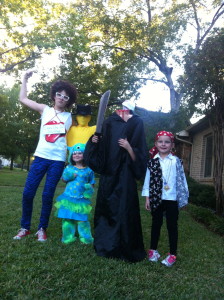 Last year was the first year that Gray was really proficient on his iPad. One of his amazing therapists agreed to come along with us and practice using his new communication skills. The iPad was loaded with all the necessary Halloween phrases and we ran dry-runs in his classroom and around the house. On Halloween evening, we loaded up and headed over to our friend’s house. Unlike in years past, she decided to go with fried chicken for dinner. Otherwise, everything was just as it had been every year. Gray burst into the house with great expectation. Then, he started whining. When we pulled out his iPad, he just kept pressing “pizza.” This is notable because, as I have mentioned before, only very close friends invite us to their houses. This is a house that we visit quite often, throughout the year, with and without various meals included. It was interesting to me to know that Gray had observed the cues to know that this was Halloween and he could expect pizza. Unfortunately, there was no pizza to be had, so Gray was pissed.
Last year was the first year that Gray was really proficient on his iPad. One of his amazing therapists agreed to come along with us and practice using his new communication skills. The iPad was loaded with all the necessary Halloween phrases and we ran dry-runs in his classroom and around the house. On Halloween evening, we loaded up and headed over to our friend’s house. Unlike in years past, she decided to go with fried chicken for dinner. Otherwise, everything was just as it had been every year. Gray burst into the house with great expectation. Then, he started whining. When we pulled out his iPad, he just kept pressing “pizza.” This is notable because, as I have mentioned before, only very close friends invite us to their houses. This is a house that we visit quite often, throughout the year, with and without various meals included. It was interesting to me to know that Gray had observed the cues to know that this was Halloween and he could expect pizza. Unfortunately, there was no pizza to be had, so Gray was pissed.
After we weathered the storm of his disappointment, we headed out for an early before-sunset trick-or-treat session. I learned my lesson about going out with him in the dark. Because we were so early, we were among the first to hit the houses and Gray had plenty of time to practice his Halloween phrases for his new audience. People were amazed and encouraging. Everyone whose house we approached waited patiently for Gray to use his iPad and then they poured extra helpings of candy in his bag. Zoe was thrilled. Gray looked very proud. Things were going very well…until we hit house #5. As we approached this house, I could see that the owners were sitting on their porch with a bucket of candy. When Gray started running towards them at full speed, I felt optimistic that he was getting the hang of this. That is until I saw what he saw: The owners were enjoying a pizza outside while they waited for the kids to arrive. I broke into a full sprint and cut Gray off just before his grimy little hand landed in the middle of their dinner. Gray dropped to the ground and had a full-on fit right their on the porch of house #5. The owners became flustered and tried to comfort him with candy and compliments on his costume, but Gray was not to be comforted. As his therapist and I dragged him back towards my friend’s house, I tried to console myself with the little bit of success that came before the fall.
Just 50 feet from our destination, Gray pulled himself together and broke away from us again. The people across the street were having a little party on their front lawn and there was a stack of pizza boxes set up on a buffet table. Fortunately, we know these people from our swimming club and they know Gray. As he ran toward their front porch, the dad said, “Hi, Gray! Want some candy?” I explained that he would gladly trade all of his candy for a slice of their pizza. He said, “No problem, he can trick or treat for pizza!” As his therapist and I caught up to Gray, we thrust the iPad into his hand and asked him what he needed to do. He whined, but went through the motions of pushing his Halloween buttons. The dad was so impressed, he loaded up a paper plate with 3 slices and handed them to Gray.
We made our way across the street and Gray sat nicely at the table enjoying his well-earned pizza. It wasn’t quite the success I had hoped for, but it was a definite step up from the year before. At least this year, with the help of his new communication device, I knew what Gray’s goal were.
Of course, we haven’t had a Halloween with Hope yet, but I am already brainstorming dog/boy duo costumes!

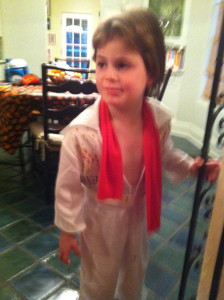
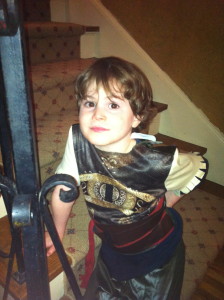
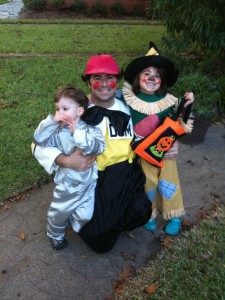
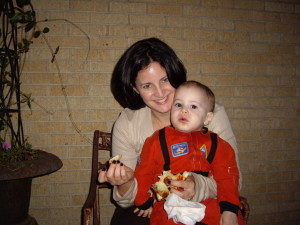
Recent Comments